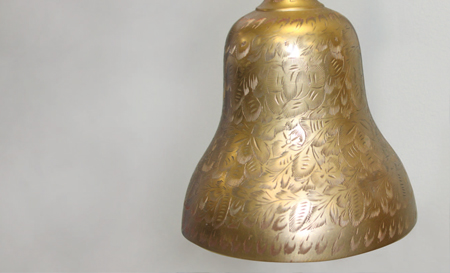In the halls of the Trinitas Wound Center, sounds of success.
By Yolanda Navarra Fleming
Among the many iconic lines from the 1946 holiday classic It’s A Wonderful Life, perhaps the most memorable is “Every time a bell rings an angel gets his wings. That’s a matter of faith, of course—and also, why not “her wings” am I right? In the Wound Center at Trinitas, there is no question about the meaning of a ringing bell. It signals that yet another patient has been healed.
Since a past director of the Wound Center found the bell in her garage and offered it to help celebrate patients being discharged, there have been thousands of among them some of the daunting, chronic cases. The Wound Center’s Clinical Coordinator, Kimberly Lee, CRN, MSN, CWCN, (left) vividly recalls a young girl being treated for a diabetic foot wound.
“She was so delighted that day that she made a video call to her father so he could watch her ring the bell,” says Kim, who has worked at the Wound Center for 13 years. “They were very close, so it meant as much to him as it did to her. They were both crying. They took pictures with the staff and we were all teary-eyed.
“Hearing the bell also gives patients in the waiting room a boost of hope that they might be the next to ring it.”
A Comprehensive Approach
The award-winning Wound Center has a 95 percent healing rate thanks to the latest technologies and years of intense study and hands-on experience. Lee’s team includes Dr. John Pepen (right, top), Dr. Georgios Kotzias (right, middle) and Dr. Morteza Khaladj, DPM, FACPPM (right, bottom)—all skilled in a wide range of healing strategies, including Vacuum-Assisted Closure (VAC) and Hyperbaric Oxygen Therapy.
VAC removes infectious material and promotes the growth of new blood vessels to prepare for grafting. The Apligraf Living Skin Device creates a biological dressing for limb-threatening venous leg ulcers and other wounds that don’t heal easily. Hyperbaric Oxygen Therapy treats an array of clinical conditions that require increased exposure to oxygen, such as diabetic foot ulcers, pressure ulcers and venous leg ulcers.
“It’s an adjunctive treatment for patients with complicated wounds that are not responding to conservative treatment,” says Dr. Pepen, Wound Care and Hyperbaric Medicine specialist, who also performs acute care surgery. Inside the Hyperbaric chamber, he explains, a patient breathes 100 percent oxygen. This improves the elimination of certain poisons, such as carbon monoxide, as well as strengthening the body’s response to infection and supporting tissue growth and wound healing.
Many patients are diabetic and acquire wounds as a result of neuropathy, which is nerve damage that can make the hands and feet numb, adds Lee.
“Most diabetic patients have neuropathy and can’t feel things on their feet because of it,” she says. “If there’s a wound on the bottom of the foot, it often gets worse before they even know it’s there. Then the wound becomes infected and spreads to the toes; the patient doesn’t notice it until their toes are black. If they’re swollen from fluid overload, all they have to do is bang into something and they have another wound.”
After two weeks of hyperbaric treatments, the doctor re-evaluates. But hyperbaric treatment works best when other aspects of a patient’s care plan are closely tended to, including not missing treatments. Next-day appointments are an option for all patients.
For diabetics in particular, regulating blood sugar levels and good nutrition are crucial. That’s why Michelle S. Ali, MPA, RD, Director of Food & Nutrition Services has joined the wound care team.
“Some patients live on a fixed income and don’t have the ability to shop or prepare elaborate meals, which means they are not eating adequately,” she says, adding that it takes a physical assessment to determine the nutritional risk of such patients, and then to attempt to guide them on food selections to make improvements. “It may be as simple as adding a cup of milk to a meal or adding peanut butter to a milkshake, in a case where the patient is consuming adequate protein but needs to increase their overall caloric intake when significant weight loss is identified.”
According to Ali, recommendations of vitamins and mineral supplements may also be essential to a patient’s healing process.
Every Day a New Challenge
Newark resident Theresa Billings, a 53-year-old with Multiple Sclerosis and poor circulation, has been a patient of the Wound Center since 2017. Her dependence upon a motorized wheelchair to get around means that for most of the day, she’s sitting with her feet down, which makes her prone to leg wounds.
“Theresa came to us with very large venous stasis ulcers,” says Wound Center Clinical Coordinator Kimberly Lee. “We have gotten them a lot smaller, but sitting all day does not help venous disease. The legs are supposed to be elevated when not walking.”
“I’m healing slowly,” says Theresa. “Dr. Pepen has tried to stay a step ahead and it’s finally getting to where he wants it to be.”
Although getting to appointments during the winter has posed a challenge, Theresa doesn’t mind going for treatment.
“It’s pleasant,” she says. “Everyone is very friendly and professional and respectful, but also funny. They work so well together and treat each other like family. I’ve never been in a hospital like that. I like everybody on the whole team because they treat patients with integrity and understanding, and they have a lot of empathy. I love that.”
Trinitas Wound Healing and Hyperbaric Medicine Center
The center is located in the Medical Office Building, 240 Williamson St., Elizabeth.
For more information, call 908.994.5480 or visit WoundHealingCenter.org.





